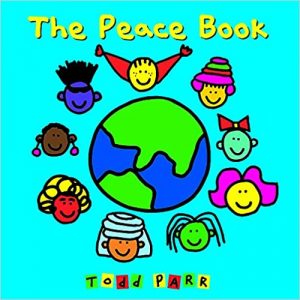Peace
The Peace Book

Author(s): Todd Parr
Links:
Amazon: https://amzn.to/2HJRYZu
Indigo: https://bit.ly/2uwEjNW
Social Justice focus: Peace
Synopsis: Each page of this simply illustrated picture book provides a different explanation of peace, following the pattern “Peace is…”
Lesson Plan: Alexandra Markes
Primary/Junior/Intermediate Lesson Plan (Abbreviated Template)
Consecutive and Concurrent Programs
Unit/Topic: Poetry
Grade: 5
Lesson: This lesson aims to show students that profound messages can come from simple words.
Curriculum Areas: Physical Education – Healthy Living
Overall: C3. Demonstrate the ability to make connections that relate to health and well-being – how their choices and behaviours affect both themselves and others, and how factors in the world around them affect their own and others’ health and well-being.
Specific: C3.2 Personal Safety and Injury Prevention – explain how a person’s actions (negative & positive) can affect the feelings, self-concept, emotional well-being, and reputation of themselves and others [PS, IS]
Curriculum Expectations:
Reading
Overall: 1. Read and demonstrate an understanding of a variety of literary, graphic, and informational texts, using a range of strategies to construct meaning;
Specific: 1.6 Extend understanding of texts by connecting the ideas in them to their own knowledge, experience, and insights, to other familiar texts, and to the world around them
Media Literacy:
Overall: 3. Create a variety of media texts for different purposes and audiences, using appropriate forms, conventions, and techniques
Specific: 3.4 produce a variety of media texts for specific purposes and audiences, using appropriate forms, conventions, and techniques
Learning Goal(s): What are students expected to know, do and understand? We are learning to….
We are learning to connect our understanding of the text to our own experiences by creating a collage of what peace means to us in order to promote positive behaviours among students in our school.
Success Criteria: How will students know they have met the learning goal? I can….
I can brainstorm ideas about what peace means to me.
I can create a collage, using PicCollage, which includes attractive texts, pictures of peace taken from the Internet and pictures of examples from around the school.
I can share my ideas about why it is important to make and keep peace in my life.
I can list ways to make and keep peace in my life.
I can work respectfully in a group.
INSTRUCTIONAL LENS: What non-curriculum considerations can be addressed in this lesson?
Peace
MODIFICATIONS / ACCOMMODATIONS: How will I meet the needs of my students? Have I addressed any IEPs?
Students will work in small groups of 3.
Instructions will be shared orally and written on the board.
Students will use a graphic organizer to organize their ideas.
Students can sit wherever they will be most productive in the classroom.
Minds-on: How will I connect to prior and future learning? How will I engage students and set the context for learning?
Minutes: 10 mins
Task: What will I be doing? What will students be doing?
Students will write what peace means to them, with a “Peace is…” sentence.
I will read The Peace Book by Todd Parr.
Students will add to their definitions of peace and share their ideas with an elbow partner.
In groups of 3, students will brainstorm the importance of making and keeping peace as well as how to make and keep peace in their live, including at school. Students will be provided with a worksheet to record their thinking.
Assessment: Diagnostic and Assessment For Learning
Action How will I introduce new learning / reinforce prior learning / practice learning / scaffold learning?
Minutes: 30 mins
Task: In groups of 3, students will be using the application, PicCollage on the iPads to create a collage about what peace means to them, why it is important to make peace and examples of peace they find on the Internet and around the school.
I will be walking around, monitoring student progress and guiding their thoughts as they go.
Assessment: Formative. Assessment as Learning
Consolidation: How will I reflect on the learning goal? How will I have students reflect on the learning goal?
Minutes: 10 mins (5 mins per group)
Task: Students will share their PicCollage collages with another group.
Assessment: Formative. Assessment as Learning
MATERIALS: What resources and materials do I need? Where can I find them? In a perfect world what other resources might I need?
iPads from the library or classroom (Access to the Internet)
The Peace Book by Todd Parr from the library (or IRC)
Peace worksheets
Pencils
REFLECTION: Questions to determine the success of your lesson:
- Were my students successful in meeting the learning goals and success criteria? How do I know?
- Did my instructional decisions meet the needs of all students? If not, what are my next steps?
- What worked well and why?
- What will I do differently in the future when teaching this lesson? For the subsequent lesson?
- What are the next steps for my professional learning?

